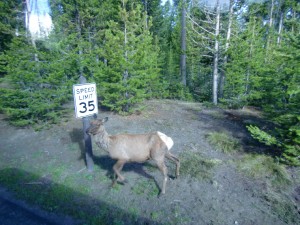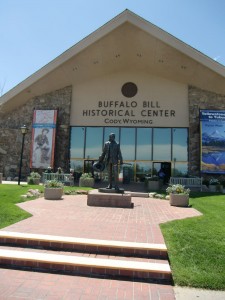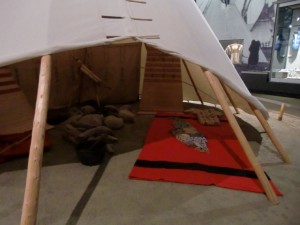THE BEST OF THE WEST – BUFFALO BILL COUNTRY
THE BEST OF THE WEST
This is the ninth in a series of articles about traveling the west by bus
BUFFALO BILL COUNTRY
By Charles N. Stevens
Photos by Dolores Seidman
Only a few pencil lines of clouds mark a golden sunrise in a clear sky.
After snacks for breakfast we take one last walk down toward Yellowstone Lake. A red squirrel warns us with his chattering then quickly disappears. The air is nippy and fresh,
but already clouds begin to fill up half the sky. The weather is constantly changing, making it difficult to know what to wear. While we wait for our ailing bus to be repaired a soft rain wets the streets. By 9:15 we’re ready to go.
The rain has ceased, but the sky is wild with both threatening clouds and patches of clear blue. We’re on our way to the east entrance of Yellowstone Park, but this time we’ll be leaving the park. While we’re still in it we enjoy our last looks at steam fumaroles here and there and elk posing by the side of the road. Snow drapes the mountain peaks across the lake. A group of buffalo stand in shallow water and graze near a fumarole, apparently at ease with the rising steam. As we rise in altitude, the temperature a chilly 55 degrees, we encounter snow on each side of the road, finally negotiating Sylvan Pass at 8530 feet. Nearby Sylvan Lake is still mostly frozen over, a sight one would not expect to see near the end of June.
Out of the park now, we continue down through a wide valley on Beartooth Highway, a road that is closed due to heavy snow from mid-October to late May. A crack of thunder announces our leaving. We stop for a rest at Pahaska Teepee where the temperature had been down to 35 degrees in the early morning. The Pahaska Teepee began as Buffalo Bill’s hunting lodge in 1904 and is now a tourist stop on the highway providing rooms, a restaurant and gift shop as well as riding horses. As rain begins to settle in and the skies turn gray and moist, we each order a hot chocolate that tastes especially good as we sit near a roaring fireplace on the chill morning. As the spectacular mountain scenery dims in rain and lightning flickers, we continue our journey towards Cody, Wyoming, the road bordering the rushing waters of the North fork of the Shoshone River.
We pass fantastic rock formations in the shapes of castles and towers, all appearing rather dark under the brooding sky. As rain clatters on the bus, wind ripples through the tall grasses and thrashes the cottonwoods. As we reach Buffalo Bill State Park and the vast Buffalo Bill Reservoir the rain ceases, but by the time we reach Cody the trees in town are bending mightily in a strong wind accompanied by blowing dust and flashes of lightning.
As we pull up to the Buffalo Bill Historical Center the full squall hits in a deluge of rain, hail and wind. While the hail bounces erratically on the sidewalk and plays a tattoo on the bus roof, we decide to wait inside until the squall has run its course.
The fit of weather over, we file into the lobby of the impressive Historical Center. This first class center is really a combination of five museums. Dolores and I decide to first visit the Buffalo Bill Museum where displays feature his Buffalo Bill’s Wild West Shows, produced here in America and in Europe. We also learn about his contributions to the fame and development of the West. He becomes more of a hero here than a showman. Next, we wander into the Plains Indian Museum where the lives and artifacts of those tribes are exhibited. Most interesting is a Teepee set up just as it would have been on the plains, one we could walk into. We spend a long while in the Whitney Gallery of Western Art where paintings and sculptures depict the varied scenery and drama of everyday life in the West. We especially note the paintings by Frederick Remington, Albert Bierstadt and George Catlin, the famous painter of Indian life.
Starving, we join the line in the restaurant, ordering barbequed pork sandwiches. They are a little messy but luscious.
Not being interested in guns, we breeze through the Cody Firearms Museum and on to the Draper Museum of Natural History. A trail-like pathway leads down to different levels of three interconnected galleries where attractive displays of western plant and animal life, one a realistic moose dipping into a mirror-like stream, delight the visitors.
It is difficult to describe such a grand museum; it needs to be visited and enjoyed. I believe it is one of the finest, well-maintained museums in the west—like a western Smithsonian.
By the time we leave near three o’clock and roll through downtown Cody, the sky is beautifully clear, the temperature a warm 82 degrees. We pass the still vital Irma Hotel, built by Buffalo Bill and named after his daughter. Outside of town the land becomes flat or sometimes rolling, most of it used for ranch and farmland, the mountain scenery of Yellowstone far behind us. Many pronghorn antelope graze or scamper across the prairie as our bus passes. Far ahead we can just make out the snow-capped peaks of the Big Horn Mountains. We pass through Emblem then arrive at Greybull, a small town on the Greybull River where cottonwood fluff fills the air like fleecy snow. It is here we learn that due to road closures we must take a longer alternate route to our destination at Sheridan, Wyoming.
Our new route takes us in to the into the Big Horn Mountains, into its black-stained sheer rock cliffs then into alpine passes of just over 9000 feet in altitude, close to snow patches. Past the mountains, we reach the town of Buffalo where we can resume our trip on Interstate 90 to Sheridan.
Finally arriving in Sheridan, hungry and weary, we are taken to JBs Restaurant for dinner. By the time we reach the Wingate Hotel, located on a hill overlooking the town, the time is 10 PM, too late to do anything but sleep.

This deer in Yellowstone Park has to slow down to 35 mph!

The Buffalo Bill Historical Center is one of the premier museums in the United States.

A tepee display inside the museum gives a good idea of the way the Plains Indians lived.

One of the flamboyant advertisements for the Buffalo Bill Wild West Show has been preserved.
MONTEREY PARK AUTHOR PUBLISHES 3RD BOOK ABOUT HIS EXPERIENCES IN WORLD WAR II- BACK FROM COMBAT
Charles “Norm” Stevens, a 40 year resident of Monterey Park and World War II Veteran has recently published the 3rd in his series about his experiences in WW II, Back from Combat: A WWII Bombardier Faces His Military Future. This book details the time from when he returned from combat in England where he flew 34 missions over Germany and France until the end of the war. Faced with large numbers of returning combat vets, and not knowing how long the war would continue, the military had to plan for their future. His options were whether to return to combat, become an instructor in the U.S., or receive new training that he would use in the Pacific. The book concludes with the end of the war with an Afterward that includes an update on the B-l7’s still flying in the U.S., as well as present day accounts pertaining to the war.
Stevens is the author of two previous books about his experiences:
An Innocent at Polebrook: A Memoir of an 8th Air Force Bombardier (Story of his 34 bombing missions from his base at Polebrook, England over Germany and France)
The Innocent Cadet: Becoming A World War II Bombardier (A prequel to the first, telling of his training in the U.S. before going overseas into combat.)
He is known to the readers of The Citizen’s Voice as the author of Travel Log Articles including “From Paris to Normandy on the Seine”, “Exploring New York” and “In Search of Snow.” He is retired, having taught for 32 years, primarily in the Montebello Unified School District.
Those interested in purchasing an autographed copy of any of his books, may contact the author at 323-721-8230 or Normstevens24@gmail.com.



